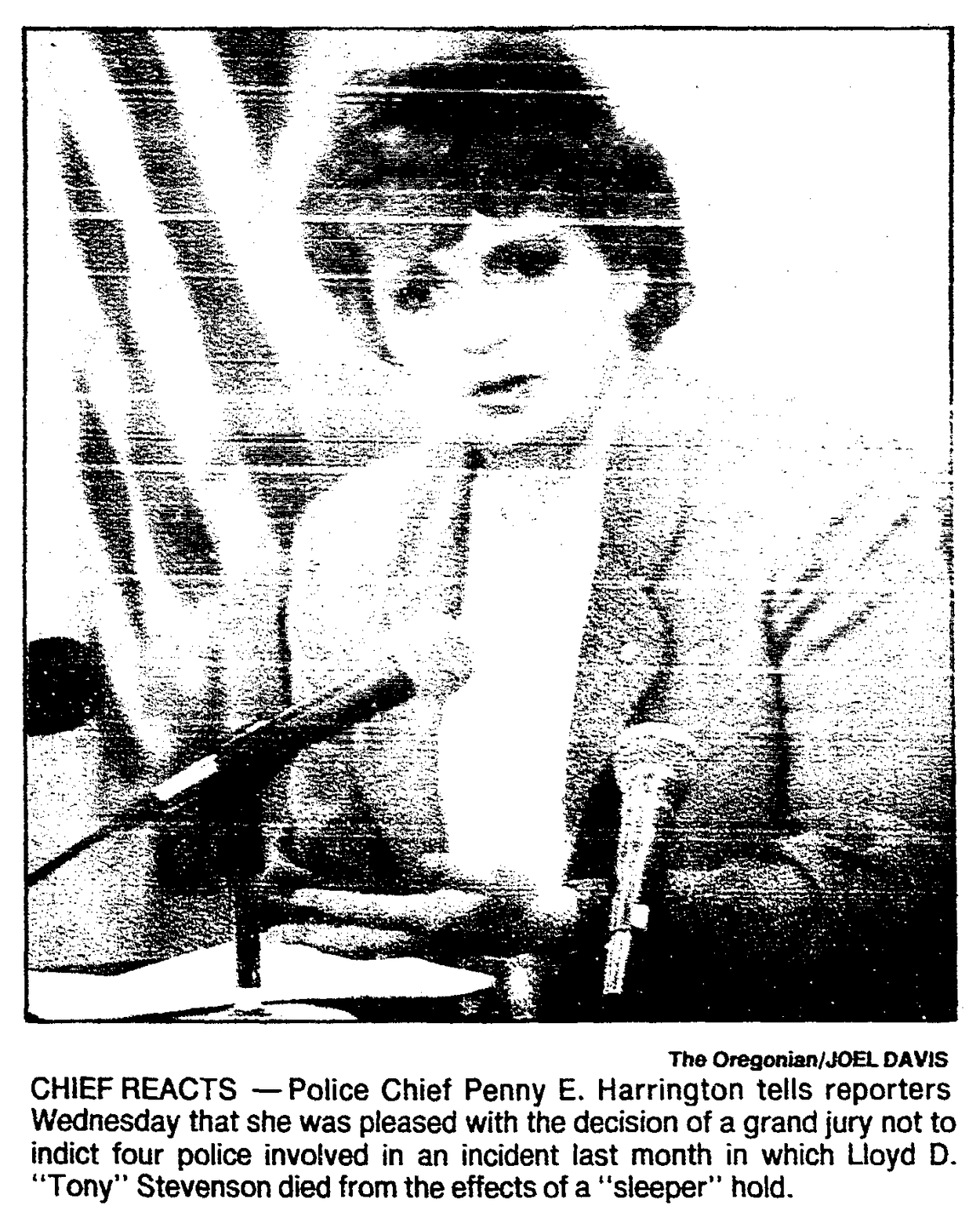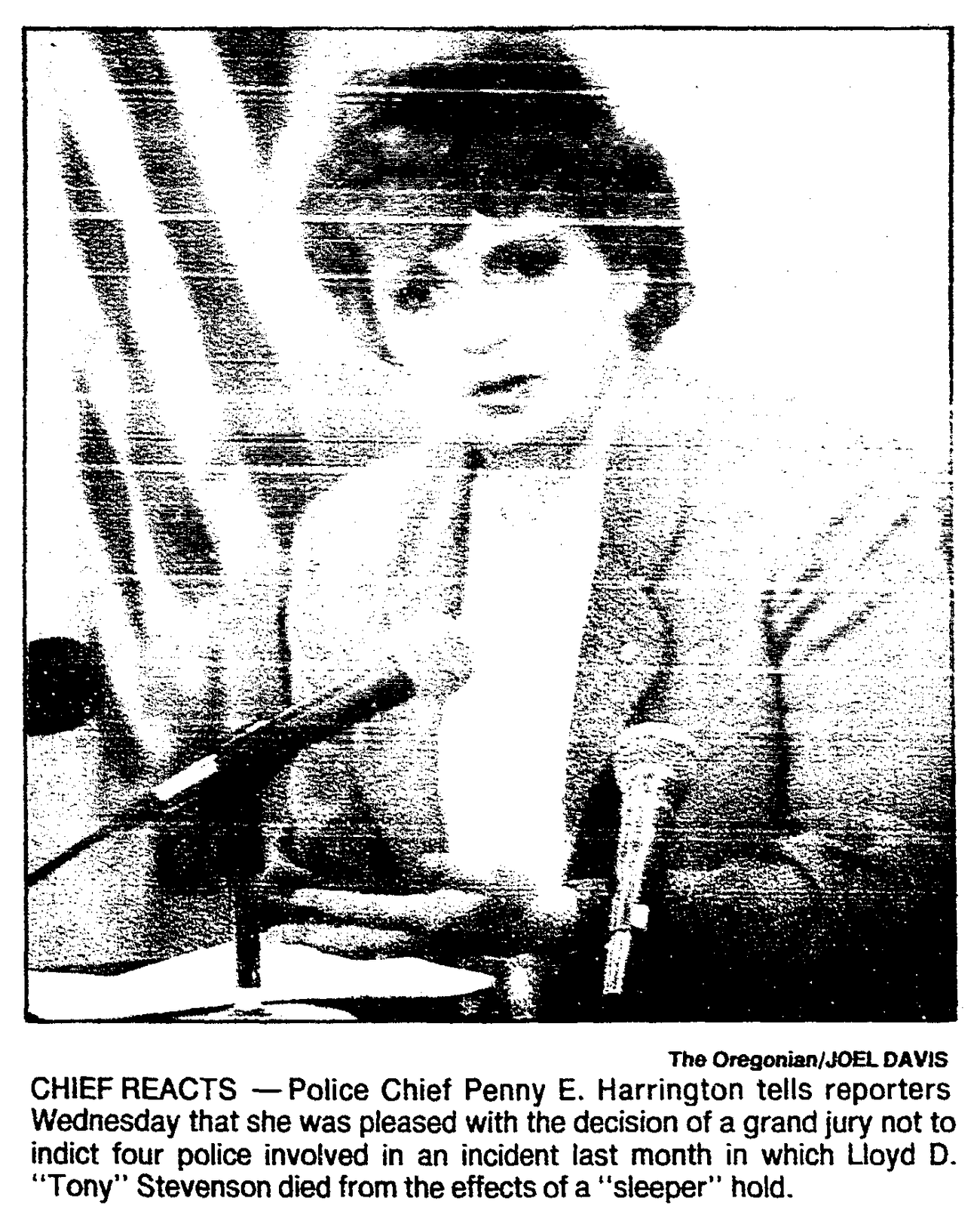Portland in a Chokehold
A race-related police incident from the 1980s, in an excerpt from a seminal study of white supremacy




As the 1950s turned into the 1960s, Blacks in Portland, like Blacks elsewhere, changed. Breakthrough events such as the Supreme Court’s ruling outlawing segregated schools in Topeka, Kansas, in 1954 put the daily unpleasantness of life in Portland in a new light, and the Montgomery bus boycott a year later suggested for the first time that you did not have to be a lawyer to fight back. The generation of children born to the shipyard workers who had remained after the war was ready to leave the ghetto and move on. Along with the proper Urban League, which had joined the NAACP as the voice of the Black community after World War II, suddenly there were Muslims, Panthers, CORE, and other more radical people and organizations willing to take their protests to the streets. Compared with other West Coast cities such as Los Angeles and Oakland, which were in the vanguard of Black protest throughout the decade, Portland was still a backwater, but it was on the map. There were even Portland-size riots among Black youth in 1967 and again in 1969.

The central issue for Black people in Portland during the 1960s and 1970s was the schools, and for good reason: Almost three-quarters of the city’s 4,800 Black students were enrolled in nine of its 94 elementary schools, nine schools whose quality can best be gauged by the fact that, despite the vast increase in Portland’s Black population since before the war, the number of Blacks entering college actually went down. It was out of a lengthy struggle against the unpopular desegregation plan that actually increased the isolation of Black schoolchildren that the militant new grassroots coalition known as the Black United Front was formed.
The 1980 victory of the Black United Front in forcing the ouster of the white school superintendent most closely identified with the failed desegregation plan and his replacement by a strong, Black former military officer who became not only the most important Black but the highest paid public official in the state of Oregon opened a new chapter in the history of race relations in Portland. There was more than just a power shift, there was an ideological one. Blacks were not so certain about integration anymore. They wanted justice. Whites were puzzled and lost. The progression from supplication to self-determination on the political agenda of Portland’s Blacks created a level of black-white tension never before present in the city. Even among whites who had stood with the Blacks at all the stages of their rising hopes and expectations there was a new sense of distance. Friends who had poured one another’s coffee at all-night strategy sessions in church basements and shepherded one another’s children at demonstrations now barely nodded in the street. As every personal transaction and every social and political institution was inspected for racism, none was found more wanting than the police force, which was 94% white.
It was now, in 1981, as long-standing complaints by Blacks about police brutality and harassment grew more insistent, that the officers from the North Precinct threw the dead opossums on the stoop of the Black-owned restaurant in the midst of the ghetto. “UPPITY NIGGERS—WE ARE STILL IN CHARGE HERE!” is what they meant. For several years after the “possum incident,” relations between the police and the Black community in Portland continued at an angry simmer, each side waiting for the other to do something wrong. Then, on April 20, 1985, at 11:30 p.m., a 31-year-old Black security guard and father of five named Lloyd Stevenson was killed by police responding to a report of a shoplifting at a neighborhood convenience store where Stevenson, who was merely a bystander, happened to be doing an errand. Attempting to subdue Stevenson, for reasons that remained unclear, an officer had applied a carotid artery “choke hold” a little too long or too hard. When the police chief promptly banned the controversial hold, two officers produced and sold T-shirts bearing the slogan “Don’t Choke ’Em, Smoke ’Em” in their precinct parking lot and the Police Athletic Club—on the day of Stevenson’s funeral. Quite a number were sold.
Stevenson was the fourth Black man killed by the police in the 10 years since 1975 and reaction in the Black community was intense. Where the possum incident had brought about 200 Black people into the streets, the death of Lloyd Stevenson brought hundreds more. In demonstrations, in newspaper and radio interviews, and at the corner barbershop, the situation of Blacks in Portland was linked to the situation of Blacks in South Africa. The police were identified with the Klan. Six months after the killing, when the T-shirt officers were reinstated through a binding arbitration—as the officers in the possum case had been—outrage erupted again. Nor were the Blacks altogether alone. However many aspects of racism Blacks believed whites would never understand, homicide was no longer one of them.
There was also a public relations factor. It was hard to imagine more of an embarrassment to a growing city openly in pursuit of Asian trade than the original possum incident but the police had managed to find one. An increasingly liberal and cosmopolitan local establishment, influenced in part by the Civil Rights Movement, believed the police were out of control. Nothing marks the movement from racism to guilt in the city’s racial politics better than the reactions of its officials to the exoneration of the T-shirt officers. “I came back feeling very good from lunch. Now I feel like going home sick,” said Portland’s populist mayor, Bud Clark, when he had to announce the arbitrator’s decision. Mike Lindberg, a leading member of the City Council, and Portland’s female police chief, Penny Harrington, were also disturbed. “It’s almost an unsupervisable police force at this time,” Lindberg said. The killing of Lloyd Stevenson revealed how tender relationships between Black people and white people in Portland had become, and particularly the hostility between the Black community and the police, but it also revealed the emergence of a new, if elementary, consensus that would strongly affect the events to come. It was: Cop or no cop, no white man is going to kill a Black man in Portland, Oregon, for no reason anymore and get away with it.
Excerpted from A Hundred Little Hitlers: The Death of a Black Man, the Trial of a White Racist, and the Rise of the Neo-Nazi Movement in America by Elinor Langer. Published by Metropolitan Books, an imprint of Henry Holt and Company. Copyright © 2003 by Elinor Langer. All rights reserved.
Elinor Langer is the author of A Hundred Little Hitlers: The Death of a Black Man, the Trial of a White Racist and the Rise of the Neo-Nazi Movement in the United States, and Josephine Herbst, a biography of the radical novelist and journalist. She is currently at work on a biography of Queen Lili’iuokalani of Hawaii.